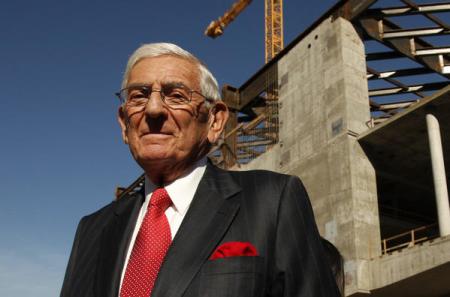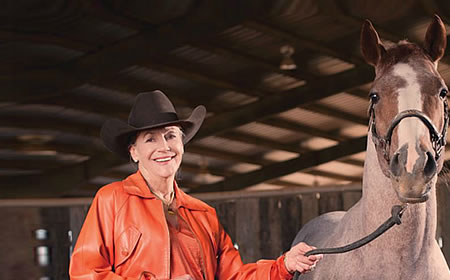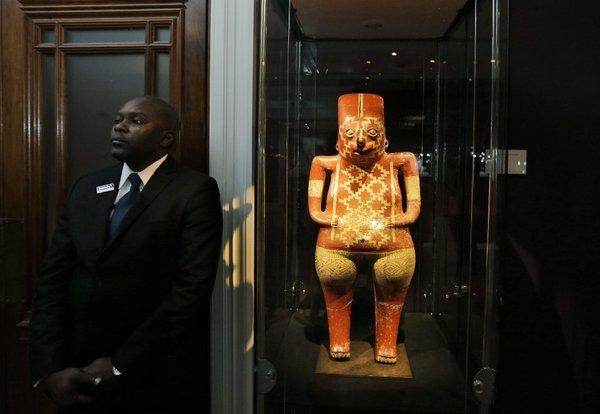Archive for the ‘Permanent Collection’ Category
Chapter 3 (Part 6): Private Collector Museum Conclusions
“If you look at history, too many great collections ended up in storage and not being shown.”[i] – Eli Broad
Eli Broad, like Alice Walton, the Fishers and George Lucas, has a long history with the city in which he practices his “venture philanthropy.” Broad was not born in Los Angeles, but like the Fishers in San Francisco, he has a long involved history with existing arts and cultural institutions. He has sat and currently sits on the boards of many art museums. Like the Fishers, Lucas and Walton, his decision to build a museum to house his art collection is motivated (partially) by his commitment to his city. But Broad is also doing something in addition to what the Fishers, Lucas and Walton did with their museums; he is utilizing his museum project as leverage for further economic growth. Sure Walton sees Crystal Bridges as having a positive economic effect on Bentonville, but there is nothing in Bentonville: Crystal Bridges is the local economy. Broad is building his museum, not in a rural city, but in the second-most highly populated city in America. Los Angeles already has the strongest brand of any city in the world, and an existing diversified economy. Sure, part of Los Angeles’ economy depend on arts and culture, but it arguably has plenty of existing organizations and venues. If Eli Broad had attempted to build his museum in a place like San Francisco, he might have come up against more public opposition as did the Fishers and Lucas.
Written by exhibitioninquisition
May 16, 2014 at 1:37 PM
Posted in Broad Art Foundation, Chicago, Contemporary, Donors, LACMA, Los Angeles, MOCA, Permanent Collection, Private Collectors, San Francisco, SFMOMA, Starchitecture, Thesis, Urban Planning
Tagged with 1% tax for arts, Alice Walton, art museums, arts administrator, basketball stadium, BCAM, Bentonville, Beverly Hills, brand, Bunker Hill, Chicago, collection, Community Redevelopment Agency, CRA, Crissy Field, Crystal Bridges, development, donors, downtown, Ed Lee, Eli Broad, Embarcadero, fundraising, George Lucas, Golden State Warriors, Grand Avenue, Grand Avenue Project, LACMA, lease, Los Angeles, Lucas Cultural Arts Museum, MOCA, NIMBY, philanthropy, Piers 30-32, Presidio Trust, private collectors, public-private investment, redevelopment, San Francisco, Santa Monica, Seawall Lot 330, SFMOMA, Snohetta, tax revenue, the Broad, the Fishers, venture philanthropy
Chapter 3 (Part 3): Alice Walton & Crystal Bridges
“I’m Alice Walton, bitch.”[i] – Alice Walton, 2007
Alice Walton is the youngest daughter of Sam Walton, founder of Wal-Mart. She was raised in Bentonville, Arkansas—also the location of the first Wal-Mart, and where Wal-Mart corporate headquarters is located. In the past decade Walton has been on a shopping spree of American art, from colonial to contemporary.[ii] The spree was fueled by her philanthropic project, the Crystal Bridges Museum of American Art (she chose the name), also in Bentonville, a city with a population of 35,000. The cost for the project is unknown, but art blogger Lee Rosenbaum (CultureGrrl) investigated the museum’s 990s and revealed that between 2005 and 2010, the museum spent $508.57 million in “expenses for charitable activities”[iii]—an intentionally vague category. These activities most like are the acquisition of art but also the design and construction of the museum by architect Moshe Safdie.
Written by exhibitioninquisition
February 13, 2014 at 1:52 PM
Posted in Acquisitions, Contemporary, Donors, Leadership, Permanent Collection, Private Collectors, Starchitecture, Thesis
Tagged with acquisition, Act 1865, admission, Alfred Stieglitz, Alice Walton, American art, Andy Warhol, Arkansas, Association of Art Museum Directors, Bentonville, Chad Alligood, Christies, collection, collector, colonial, Contemporary, Crystal Bridges, cultural tourism, CultureGrrl, Dolly Parton, Don Bacigalupi, donor, endowment, Fisk University, Frank Lloyd Wright, Georgia O’Keefe, grant, hotel, Jackson Pollock, Mark Rothko, Moshe Safdie, museum, No. 210/No. 211 (Orange), painting, restaurant, State of Arkansas, Wal-Mart
Chapter 1 (Part 2): LACMA’s BCAM – A Museum Within a Museum
“Even though Eli is not involved with the museum any longer, his name is still on that building. We should have never called it a museum. How can LACMA have a museum? LACMA is the museum.”
– Lynda Resnick, LACMA Trustee[i]
In February 2008, the Broad Contemporary Art Museum (BCAM) opened at the Los Angeles County Museum of Art (LACMA). The Renzo Piano-designed BCAM is not an autonomous museum; it is one of several buildings on LACMA’s museum campus (the largest American art museum west of Chicago).
LACMA was founded in 1961, when it seceded from the Los Angeles Museum of History, Science and Art in Exposition Park. The new art museum opened in 1965 with three buildings designed by William Pereira: the Bing, Ahmanson and Hammer buildings. In 1986, the Art of the Americas Building (then the Anderson Building) opened, and was followed in 1988, with the Pavilion for Japanese Art. The museum continued to grow when LACMA purchased the neighboring May Company department store building in 1994. (LACMA is currently collaborating with the Academy of Motion Picture Arts and Sciences to bring a museum to the vacant building.[ii]) In 2001, plans for a tabula rasa campus designed by Rem Koolhaas were scrapped due to its ambitious scale (all existing buildings would have been raised) and lack of public support (a proposed bill would have provided public funds for the project, but was not passed by voters[iii]). Then in 2004, the board approved a multi-year capital campaign called Transformation.[iv]
Michael Govan, Wallis Annenberg Director and CEO of LACMA, inherited Transformation when he took LACMA’s helm in 2006 (little more than a year before BCAM’s inauguration). Exciting, high profile, high-cost building projects are Govan’s specialty. Before coming to LACMA, Govan had been the director of the Dia Art Foundation where he oversaw the renovation of an old Nabisco factory in the Hudson River Valley, into Dia Beacon—a gargantuan facility capable of housing many large-scale, contemporary art installations. Before Dia, Govan worked under Richard Armstrong at the Guggenheim Foundation and aided in the realization of the Guggenheim Bilbao. Govan had the resume required to lead LACMA during Transformation. Eli Broad was on the search committee that lured Govan to LACMA.[v]
Written by exhibitioninquisition
June 27, 2013 at 2:27 AM
Posted in Acquisitions, Broad Art Foundation, Contemporary, Donors, LACMA, Leadership, Los Angeles, Permanent Collection, Private Collectors, Starchitecture, Thesis
Tagged with Academy of Motion Picture Arts and Sciences, acquisition, Ahmanson, Ai WeiWei, Art of the Americas, Art of the Pacific, Art+Film Gala, Barbara Kruger, BCAM, Bing, British Petroleum, Broad Art Foundation, Broad Contemporary Art Museum, Bruce Nauman, building, campus, capital campaign, Chris Burden, Christian Marclay, Christopher Knight, City of Los Angeles, collection, contemporary art, corten steel, Craig Kauffman, curator, Dia Art Foundation, Dia Beacon, director, donor, Ed Ruscha, Edvard Munch, Edward Kienholz, Eli Broad, exhibition, Franklin Sirmans, Franz West, Gallery, Glen Ligon, Glenn Lowry, Guggenheim Bilbao, Guggenheim Foundation, Hammer, James Turrell, John Baldessari, Jorge Pardo, Julio Le Parc, Leon Black, Levitated Mass, Los Angeles County Museum of Art, Lynda Resnick, Mark Hagen, May Company, Metropolis II, Michael Govan, Michael Heizer, MOCA, model, MOMA, National Gallery, Nicolas Berggruen, Pavilion for Japanese Art, Peter Zumthor, philanthropy, Pre-Columbian, Rem Koolhaas, Renzo Piano, Resnick Pavilion, Richard Armstrong, Richard Serra, Robert Irwin, Robert Rauschenberg, Rodarte, Sequence, Shirin Neshat, The Scream, Theaster Gates, Transformation, travertine, trustee, update, William Pereira, Wilshire Blvd
Chupícuaro “Large Figurine” Type
Barbier-Mueller Collection at Sotheby’s Paris
In March, Sotheby’s held an auction in Paris of the Barbier-Mueller collection that was a flop. Gleeful announcements of new auction records and shattered high estimates have become customary in the high end art market; so what went wrong in this case? The Barbier-Mueller trove of Pre-Columbian art was created over two generations, was widely-published, and had been on public display at the Barbier-Mueller Museum of Pre-Columbian Art in Barcelona. When an arrangement with the Spanish Government to put the collection on permanent display fell through,[i] the owner, Jean Paul Barbier, decided to sell.
The two-day auction brought in $13,375,000—a pittance compared to the $19-24 million estimate—and fewer than half of the 313 lots found buyers. The PR spin-doctors of Sotheby’s focused on the fact that the sale had set a new record for Pre-Columbian Art. In the post-sale press release,[ii] president of Sotheby’s France, Guillaume Cerutti, said: “Despite having achieved less than expected, these results are good considering the context in which the sale unfolded.”
Written by exhibitioninquisition
May 31, 2013 at 11:53 AM
Posted in Acquisitions, Art Institute, de Young Museum, Donors, LACMA, Los Angeles, Permanent Collection, Private Collectors, Restitution, San Francisco
Tagged with archeological, archeologist, Art, Art Institute of Chicago, art market, auction, auction house, Barbier, Barbier-Mueller Museum of Pre-Columbian Art, Barcelona, bellybutton, burial, ceramic, Christies, Chupícuaro, collection, Costa Rica, estimate, excavation, Fine Art Museums of San Francisco, firing holes, forgeries, France, Grande Vénus Callipyge, Guanajuato, Guatemala, Guillaume Cerutti, iconographic, Jean Paul Barbier, LACMA, Large Figurine, Latin America, Lerma River, Logan Collection, logo, looting, Los Angeles, Los Angeles County Museum of Art, Louvre, market, Metropolitan, Mexico, Mueller, Muriel Porter, Musée du Quai Branly, museum, National Museum of Anthropology of Mexico, National Museum of the American Indian, Natural History Museum, Paris, Pavillon Des Sessions, Peru, Pre-Columbian, press release, provenance, record, red on buff, Richard Townsend, Solis Damn, Sothebys, Spanish Government, St. Louis Museum of Art, textile, Type, Venus of Willendorf, Visible Vault
Four Facts: Significant Objects
Norton Simon Museum
As I was finishing up in this exhibition, I overheard a tour being given to what I presumed was a UCLA summer painting course. “We have the Getty in our own backyard, but the Getty’s collection kinda sucks. The Norton Simon’s is the really great collection of LA,” the teacher harped. I am paraphrasing. While I detest uninformed and unnecessary opinions (especially from arts educators) about which museum has the “best” collection, I can’t deny the Norton Simon has a pretty amazing one, and I don’t even like Impressionism. Significant Objects: The Spell of the Still Life presents a thematic cross section of the museum’s diverse collections and is an examination of “the ways in which these ostensibly mundane and insignificant subjects [harsh!] portrayed in painting and sculpture and works on paper are indeed significant.” Significant Objects does not present groundbreaking, paradigm shift-type discoveries or research, but is a huge success as a rich, educational opportunity for general audiences utilizing the permanent collection. Permanent collection show hurray! Here are the facts:
Written by exhibitioninquisition
August 8, 2012 at 1:12 AM
Posted in Contemporary, Four Facts, Los Angeles, Norton Simon, Permanent Collection
Tagged with Admiraels de gouda, Allegory, Aubert-Henri-Joseph Parent, Blow Up, broken, bulb, capitalism, chaekkeori, Claes Oldenbrurg, connoisseurship, Constitution of 1791, contemporary art, drawing, exhibition, flamed, French Monarchy, gallery guard, Getty, Giant Soft Ketchup Bottle with Ketchup, gilders, Great Tulip Book, impressionism, Joseon dynasty, Korean, LACMA, Lemons, loans, museum, National Endowment for the Arts, Norton Simon, Oranges, Ori Gersht, original, Pasadena Art Alliance, Pasadena Museum of Art, Permanent Collection, relief, Rose, Santa Barbara Museum of Art, Selma Holo, Semper augustus, Sharon Core, Significant Objects, speculation crisis, Stendhal syndrome, still life, Still Life with Steak, tattoo, tulip, tulip bubble, Tulipmania, varieties, wunderkammer, Zurburan




